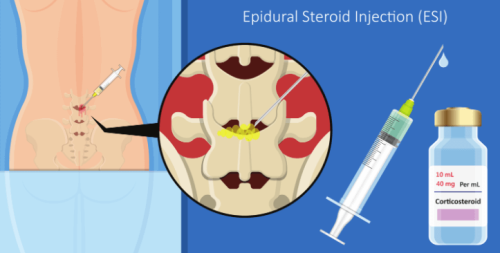“My doctor recommended that I should have a cortisone injection for my back pain. What’s your opinion of having cortisone injections” is a common question I hear from patients.
My general response to this question is to point out that it doesn’t matter what my opinion is of cortisone injections. What’s most important for you is what the research shows about cortisone injections. Does the research suggest that cortisone injections are a safe and effective approach for back pain or not? THAT’S what’s most important…
What Is a Cortisone Injection?
A spinal cortisone injection, also known as an epidural steroid injection (ESI), is a procedure that involves injecting a corticosteroid, like cortisone, into the epidural space around the spinal cord. The injection is used to treat chronic pain caused by inflamed spinal nerves.
The use of epidural glucocorticoid injections in patients with herniated disks has increased rapidly in recent years, although these injections are used on an off-label basis.
What Does the Science Say About Cortisone Injections?
A 2016 systematic review by Deyo and Mirza showed that “patients with radiculopathy (referred pain) who received epidural glucocorticoid injections had slightly better pain relief (by 7.5 points on a 100-point scale) – (MEANING CLINICALLY MEANINGLESS) and functional improvement at 2 weeks than patients who received placebo. There were no significant advantages at later follow-up and no effect on long-term rates of surgery.”
When any drug/procedure like cortisone injections are used “off-label” it is actually fancy “science speak” for” there is insufficient scientific evidence to support its use.”
What Are the Risks?
Deyo and Mirza noted that “Procedural complications are rare, but neurologic events such as paraplegia have been reported, and the Food and Drug Administration recently required a warning on product labels for glucocorticoids. Systemic side effects, including cortisol suppression (damage to your adrenal gland) and osteopenia (weakening of bone) may also occur”
Although rare, other reported risks and complications that apply to cortisone injections include: low blood pressure, severe headache caused by spinal fluid leakage, infection from the epidural procedure, such as an epidural abscess, discitis, osteomyelitis or meningitis.
Yet, despite this lack of evidence of benefit and evidence of serious potential harm the off-label use of these injections,” has increased rapidly in recent years.”
Why Do Doctors Prescribe Cortisone Injections for Back Pain Then?
In light of what the science says, that is a very puzzling question…
According to Bishop et al 2010 in the Spine Journal, medical education failing to keep up with the science is the culprit: “Multiple studies have demonstrated a poor correlation between what medical physicians think is an effective treatment and what has actually been shown to be an effective treatment.”
What Does the Science Say Is the Safest and Most Effective Therapy in Dealing with Back Pain?
Studies from Manga (1993), Manga and Angus (1998), Meade (1990 and 1995), Legoretta (2004), Fersum (2006), Sarnat (2007), Cleland (2007), Bishop (2010), Citfuentes (2011), Von Heymann(2013), Bronfort (2014), Schneider (2015), Evans (2018) all showed that the safest, most effective, most cost-effective treatment for back pain is CHIROPRACTIC CARE. In addition, it showed that chiropractic care also significantly reduced other healthcare costs!

Chiropractic care has been shown scientifically to be the most effective care for back pain
So, the science says that spinal cortisone injections have a clinically meaningless benefit and some pretty serious risks. If you want the most scientifically proven option to help your back pain which is also cheaper (and could save you on other potential healthcare costs) you may want to consider seeing a chiropractor.
References:
Deyo, R.A, and Mirza, K. (2016) Herniated Lumbar Intervertebral Disk – Clinical Practice. N Engl J Med; 374:1763-72
Bishop, et al. (2010). The Spine Journal 10: 1055-64
Manga, et al. (1993). The Manga Report: The effectiveness and cost-effectiveness of chiropractic
management of low-back pain. Richmond Hill, Ontario, CANADA. Kenilworth Publishing (An
Independent Report Commissioned by the Ontario Provincial Government).
Manga & Angus (1998). Enhanced Chiropractic Coverage Under OHIP as a Means of Reducing Health Care
Costs, Attaining Better Outcomes and Achieving Equitable Access to Health Services.
Meade, T.W. et al. (1990) Low back pain of mechanical origin: randomized comparison of chiropractic
and hospital outpatient treatment. BMJ 300: 1431-1437
Meade, T.W. et al. (1995) Randomized comparison of chiropractic and hospital outpatient management
for low back pain: results from extended follow up. BMJ 311: 349
Legorreta, et al. (2004). Comparative Analysis of Individuals With and Without Chiropractic Coverage:
patient characteristics, utilization, and costs. Archives of Internal Medicine 164(18): 1985-92
Fersum, K.V. (2006) Spinal manipulation and exercise was better than ultrasound and exercise for
patients with chronic low back pain. Journal of Physiotherapy Vol 52 Issue 4:306).
Sarnat et al. (2007) Clinical Utilization and Cost Outcomes from an Integrative Medicine Independent
Physician Association.: An Additional 3-Year Update JMPT 30 (5) 263-269).
Cleland et al (2007) Short-term Effects of Thrust Versus Nonthrust Mobilization/Manipulation Directed
at the Thoracic Spine in Patients with Neck Pain: a Randomized Clinical Trial. Physical Therapy; 87 (4):
431-440).
Bishop, et al. (2010). The Chiropractic Hospital-based Interventions Research Outcomes (CHIRO) Study: a
randomized controlled trial on the effectiveness of clinical practice guidelines in the medical and
chiropractic management of patients with acute mechanical low back pain. The Spine Journal 10: 1055-64
Cifuentes et al. (2011) Health Maintenance Care in Work-Related Low Back Pain and its Association
With Disability Recurrence. Journal of Occupational and Environmental Medicine pp 190-198
Von Heymann, W. et al. (2013) Spinal High-Velocity Low Amplitude Manipulation in Acute Nonspecific
Low Back Pain: A Double-Blinded Randomized Controlled Trial in Comparison with Diclofenac
[Voltaren] and Placebo. Spine 38 (7): 540-548
Bronfort, G. et al. (2014) Spinal Manipulation and Home Exercise with Advice for Subacute and
Chronic Back-Related Leg Pain. Ann Intern Med. 161:381-391
Schneider et al. (2015) Comparison of Spinal Manipulation Methods and Usual Medical Care for Acute
and Subacute Low Back Pain: A Randomized Clinical Trial. Spine 2015; 40:209-217
Evans, R. et al. Spinal manipulation and exercise for low back pain in adolescents: a randomized trial.
Pain (2018) 159(7):1297-1307.
